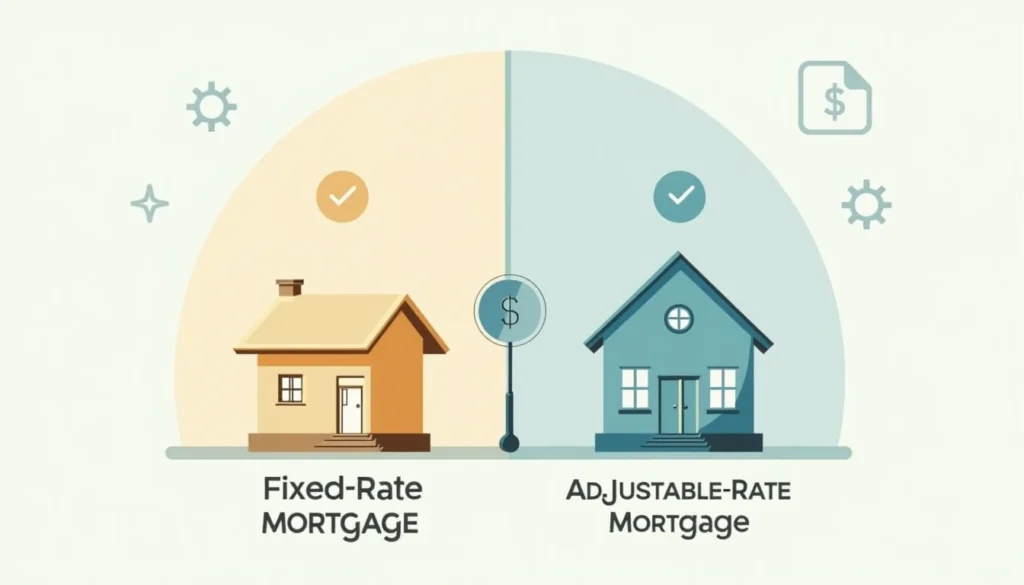When buying a home, one of the most important decisions you’ll make is choosing between a fixed-rate mortgage and an adjustable-rate mortgage (ARM). Each option has its own advantages and disadvantages, and the best choice depends on your financial goals, how long you plan to stay in the home, and your risk tolerance.
In this guide, we’ll break down the key differences between fixed and adjustable-rate mortgages, so you can make an informed decision that fits your budget and lifestyle.
What Is a Fixed-Rate Mortgage?
A fixed-rate mortgage has an interest rate that remains the same for the entire term of the loan. Whether you choose a 15-year or 30-year mortgage, your monthly principal and interest payments will stay consistent, offering predictability and peace of mind.
✅ Pros of a Fixed-Rate Mortgage
- Predictable payments: Your interest rate won’t change, making it easier to budget long-term.
- Stability during rising rates: If interest rates rise in the future, you’re locked into a lower rate.
- Long-term planning: Ideal if you plan to stay in your home for many years.
❌ Cons of a Fixed-Rate Mortgage
- Higher initial rate: Fixed rates are often higher than the initial rate of an ARM.
- Less flexibility: If rates drop significantly, you’d need to refinance to benefit.
What Is an Adjustable-Rate Mortgage (ARM)?
An adjustable-rate mortgage (ARM) starts with a lower fixed interest rate for an initial period (commonly 5, 7, or 10 years), after which the rate adjusts periodically based on a benchmark index like the LIBOR or SOFR.
ARMs are labeled as 5/1, 7/1, or 10/1, meaning the rate is fixed for 5, 7, or 10 years, and then adjusts every year afterward.
✅ Pros of an Adjustable-Rate Mortgage
- Lower initial rate: You could pay significantly less in interest during the initial fixed period.
- Great for short-term homeowners: If you plan to move or refinance before the adjustable period begins, you may save money.
- Potential savings: If rates drop over time, your payment may go down.
❌ Cons of an Adjustable-Rate Mortgage
- Uncertainty: After the initial period, your payments may rise dramatically.
- Risk of payment shock: If rates spike, your monthly budget could be strained.
- Complex terms: ARMs often have caps, floors, and margin terms that can be confusing to borrowers.
Fixed vs. ARM: Which Is Right for You?
Choosing between a fixed or adjustable-rate mortgage depends on a few key factors:
📍 How long do you plan to stay in the home?
If you expect to stay in your home long-term, a fixed-rate mortgage offers the security of consistent payments. On the other hand, if you’re buying a starter home or relocating in a few years, an ARM might make more sense financially.
💰 What’s your risk tolerance?
If the idea of fluctuating interest rates makes you nervous, a fixed-rate mortgage may be your best bet. If you’re comfortable taking a calculated risk for potential savings, an ARM can be a smart choice—especially if rates are low or you plan to sell before the rate adjusts.
📈 Where are interest rates headed?
If rates are low and expected to rise, locking in a fixed rate can be a wise move. If rates are high or likely to fall, an ARM could result in a lower long-term cost—just remember the risks involved with changing rates.
Cost Comparison Example
Let’s say you’re borrowing $300,000:
- Fixed-rate mortgage at 6.5% for 30 years: Monthly principal & interest = ~$1,896
- 5/1 ARM with 5.5% initial rate: Monthly principal & interest = ~$1,703 (for first 5 years)
That’s a savings of nearly $200 per month in the first 5 years with the ARM. But if the rate increases to 7.5% later, your payment could rise to over $2,097/month.
Use Our Mortgage Calculator to Compare Options
Still not sure which is right for you? Try our Mortgage Calculator to estimate payments for both fixed and adjustable-rate loans. It’s fast, free, and designed to help you make smarter decisions.
Final Thoughts
Both fixed and adjustable-rate mortgages offer benefits and risks. A fixed-rate loan gives you stability and peace of mind, while an ARM offers lower upfront costs that can benefit short-term homeowners. Evaluate your personal goals, financial situation, and how long you plan to own the home before making a decision.
Need help calculating your monthly payment or comparing loan types? Visit HomeFinanceTools.com for free tools, calculators, and expert advice to make your home-buying journey easier and more affordable.

